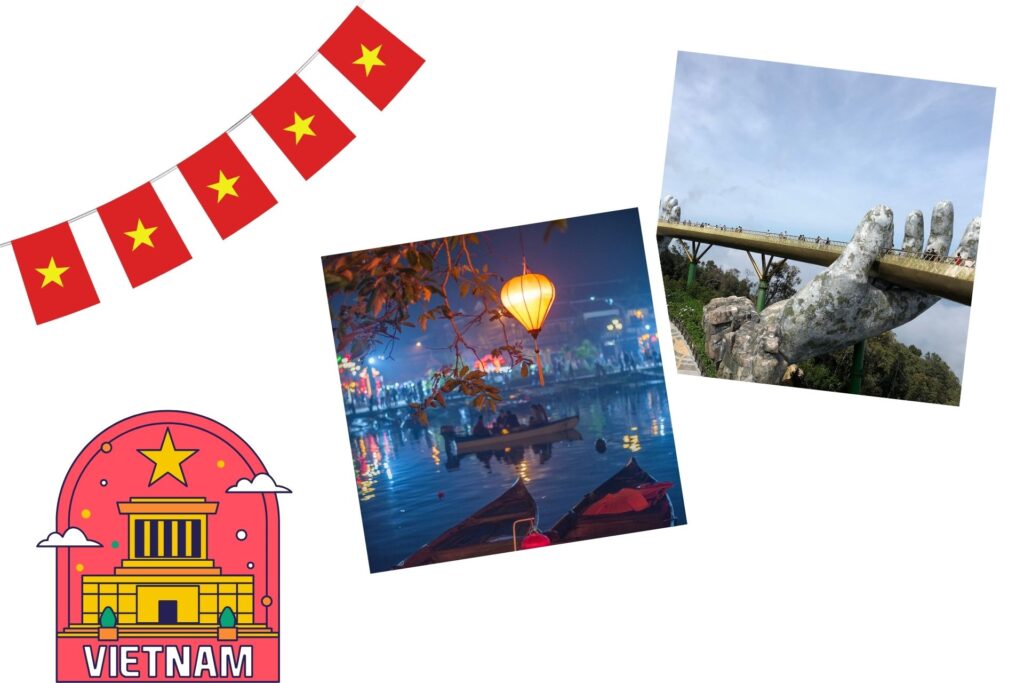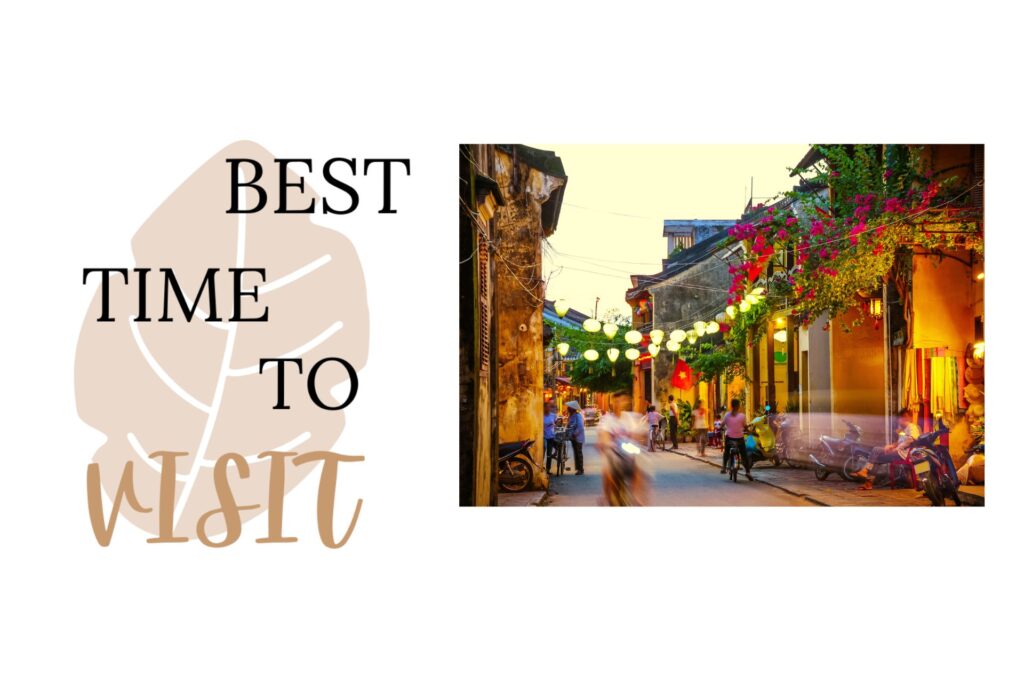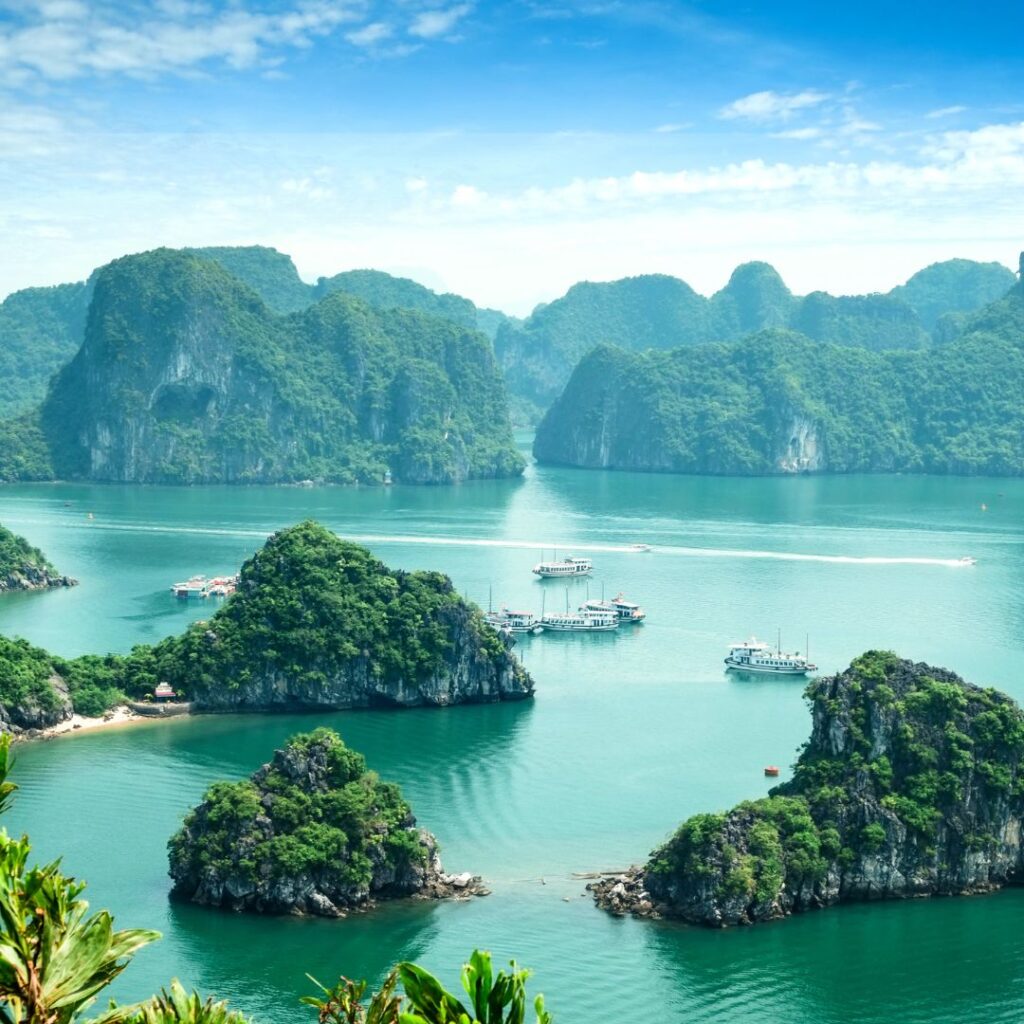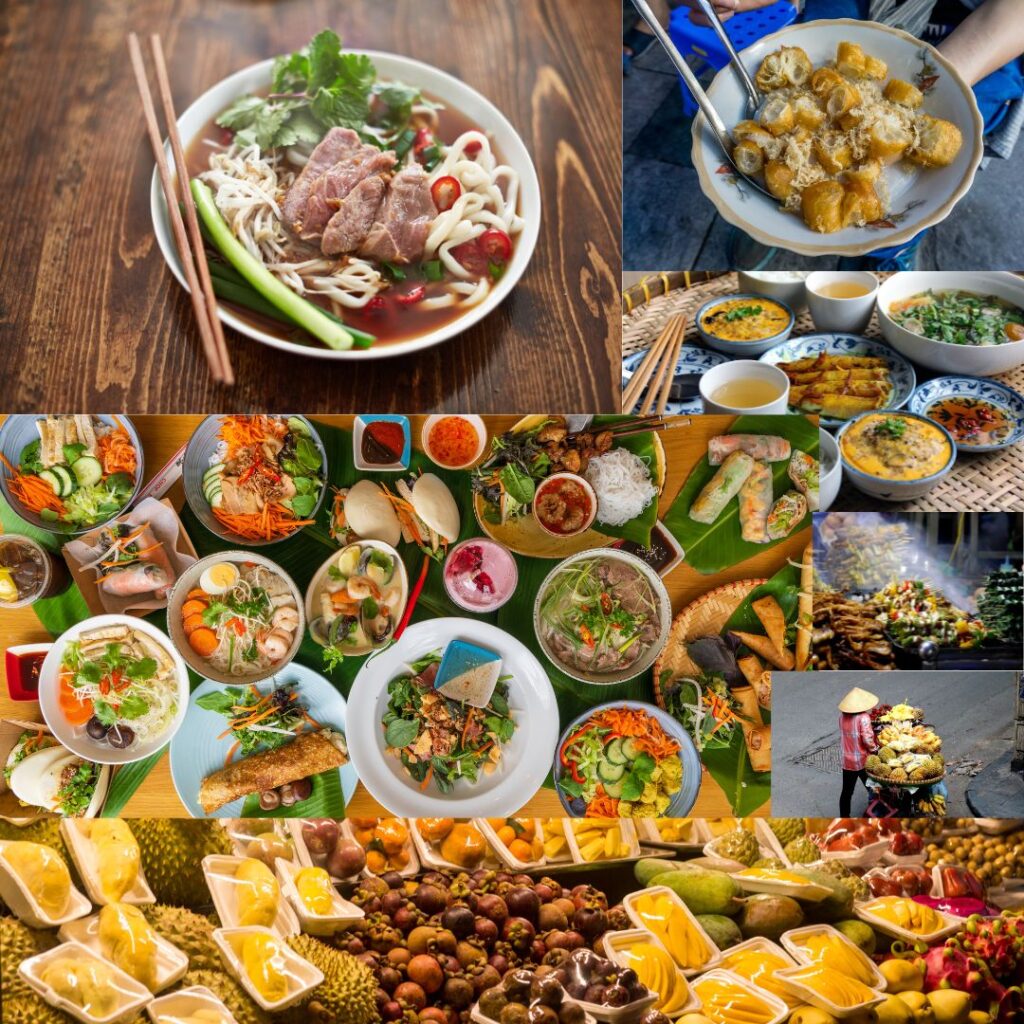VIETNAM

Discover Vietnam: A Land of Timeless Beauty and Adventure
Vietnam is a dream destination for travelers seeking a perfect blend of breathtaking landscapes, rich history, and vibrant culture. Whether you’re an adventure seeker, a history buff, or a foodie, Vietnam offers something for everyone.
Vietnam: A Land of Endless Wonders and Unforgettable Experiences
From emerald-green rice paddies to bustling city streets, Vietnam is a land of contrasts, where ancient traditions meet modern vibrancy. Whether you’re cruising through the misty limestone karsts of Halong Bay, wandering the lantern-lit alleys of Hoi An, or savoring a steaming bowl of pho in a lively street market, every moment in Vietnam is an adventure waiting to be discovered. With its breathtaking landscapes, deep-rooted history, and warm, welcoming people, Vietnam promises an unforgettable journey for every traveler.

Vietnam has a diverse climate due to its long, narrow shape, so the best time to visit depends on which region you plan to explore. However, the most ideal months for visiting the entire country are March to April and September to November, when the weather is generally pleasant and dry.
Summary – When to Visit Based on Travel Interests



What to expect?
Language: The official language inVietnam is Vietnamese.
Currency: The currency of Vietnam is theVietnamese đồng (VND).
Credit Cards and ATMs:
- Credit Cards: Accepted in most hotels, restaurants, and larger stores, but it’s still good to carry cash for smaller establishments.
- ATMs: Widely available in cities, with major banks offering services. Always check the fees associated with withdrawing from international cards.
- Tip: ATM withdrawals are usually in VND, and international cards like Visa or MasterCard work well in urban areas.
Plugs: Plug Type A, C, or D (two-pin for type A and C, three-pin for type D)
Voltage 220V, 50Hz. If your devices are not compatible, you’ll need a voltage converter and plug adapter.
Safety:
- General Safety: Vietnam is generally safe for travelers. Petty crimes like pickpocketing can happen, especially in crowded areas or tourist spots, so stay alert.
- Scams: Watch out for common scams targeting tourists (e.g., overcharging taxis, fake tour operators). Always agree on prices upfront for taxis or services.
- Traffic: Traffic in Vietnam can be chaotic, especially in big cities like Hanoi and Ho Chi Minh City, so be cautious when crossing streets.

Pro tip for Vietnam
One pro tip is to travel by train or sleeper bus for longer journeys—these are affordable, and the train ride offers stunning views, especially on the route from Hanoi to Sapa or Hue to Da Nang. When visiting cities like Hanoi or Ho Chi Minh City, use Grab (the Southeast Asian version of Uber) for reliable, inexpensive transport. For local experiences, always try to sample the country’s signature dishes like pho (noodle soup), banh mi (baguette sandwich), and fresh spring rolls from street vendors, as they often serve the best and most authentic versions.
If you’re heading to places like Ha Long Bay or Phong Nha-Kẻ Bàng National Park, try to book tours or transport in advance, especially during peak season (from December to February), to avoid long waits or high prices. Another tip is to pack light—Vietnam’s weather can be quite humid and warm, so lightweight clothing is essential, but don’t forget a rain jacket for the frequent showers. Be cautious about street food hygiene—while delicious, make sure you eat at busy stalls or those recommended by locals to avoid any stomach issues. Finally, take the time to learn a few basic Vietnamese phrases like “Cảm ơn” (thank you) and “Xin chào” (hello), as it can go a long way in making your interactions more enjoyable.
Getting around
Getting around in Ha Long Bay
Exploring Ha Long Bay is best done by boat, as the bay is made up of thousands of limestone islands and islets. The most popular way to see the bay is through a day cruise, which typically includes visits to key islands, caves, and opportunities for activities like kayaking or swimming. For a more immersive experience, opt for an overnight cruise, where you can relax on the water, enjoy stunning sunsets, and wake up to the bay’s serene beauty. Many cruises offer kayak rentals for exploring the caves and grottoes, and some also stop at Cat Ba Island, known for its hiking and natural parks. To get to Ha Long Bay, you can travel from Hanoi by bus, private car, or join a guided tour that includes transportation. Whether on a large cruise or a private boat, Ha Long Bay offers a peaceful and picturesque escape, best explored at a relaxed pace on the water.


Getting from Island to Island
In the north, start with Cat Ba Island, known for its rugged mountains, sandy beaches, and proximity to Ha Long Bay. It’s perfect for hiking, kayaking, and exploring the Cat Ba National Park. For a more remote experience, head to the small Bai Tu Long Bay which is less crowded than Ha Long Bay but equally beautiful, often accessed by boat from Cat Ba.
Moving south, the central islands like Phu Quoc offer a tropical paradise with white sandy beaches, clear waters, and a relaxed vibe. It’s great for diving, snorkeling, and indulging in fresh seafood. Not far from Phu Quoc, you can visit the Con Dao Islands, which are known for their pristine nature, historical significance, and quiet atmosphere—perfect for a more laid-back island experience.
For a mix of adventure and cultural exploration, the southern islands like Koh Rong and Can Gio provide more rustic beauty and are less touristy. Koh Rong offers crystal-clear water, ideal for diving, while Can Gio is famous for its mangrove forests and wildlife.
To get around, ferries, speedboats, or even small private boats are commonly used to hop between these islands, and flights are available for the larger ones like Phu Quoc. Make sure to plan your routes and transportation in advance, especially during the peak tourist season (November to April).
Foods you have to try in Vietnam
Vietnam is a food lover’s paradise, offering an array of delicious and flavorful dishes that reflect the country’s diverse regions. A must-try is pho, the iconic Vietnamese noodle soup made with a savory broth, rice noodles, and your choice of meat (usually beef or chicken), topped with fresh herbs, lime, and chili. Another popular dish is banh mi, a Vietnamese baguette sandwich filled with meats like pork, chicken, or pâté, along with fresh vegetables and herbs—it’s a perfect fusion of French and Vietnamese influences.
For a fresh and light dish, try goi cuon (Vietnamese spring rolls), made with shrimp, herbs, lettuce, and vermicelli wrapped in rice paper and served with a peanut or hoisin dipping sauce. Bun cha, a Hanoi specialty, features grilled pork patties and slices of pork belly served with vermicelli noodles, fresh herbs, and a side of dipping sauce. If you love seafood, try cha ca—grilled fish served with turmeric, dill, and vermicelli noodles.
Don’t miss out on com tam, or broken rice, usually served with grilled pork, but also found with other meats like chicken or beef. For dessert, indulge in che, a sweet, refreshing Vietnamese dessert made with beans, fruits, and coconut milk. To wash it all down, try cà phê sữa đá, Vietnamese iced coffee with sweetened condensed milk, or the more adventurous egg coffee, a creamy concoction made with whipped egg yolks and condensed milk.
Vietnam’s street food scene is a true highlight, so don’t hesitate to explore local markets and street vendors to get an authentic taste of these delicious dishes.





Ultimate itinerary for Vietnam
An ultimate itinerary for Vietnam offers a perfect mix of vibrant cities, breathtaking landscapes, and rich cultural experiences. Here’s a suggestion for a 10-day journey:
Day 1-2: Hanoi
Arrival in Hanoi, the capital, and explore its charming Old Quarter with narrow streets, colonial architecture, and buzzing markets.
Visit Hoan Kiem Lake and the Ngoc Son Temple nearby.
Explore the historical Ho Chi Minh Mausoleum and his Stilt House, and learn about Vietnam’s history at the Vietnam Museum of Ethnology.
Enjoy authentic pho and egg coffee in local cafés.
Take an evening water puppet show to experience Vietnamese art and culture.
Day 3-4: Ha Long Bay
Take a day or overnight cruise in Ha Long Bay, a UNESCO World Heritage site known for its stunning limestone karsts and emerald waters.
Go kayaking, swim, or visit caves like Sung Sot Cave.
If time allows, explore nearby Cat Ba Island, which offers hiking and beautiful beaches.
Day 5-6: Hue
Head south to Hue, the former imperial capital. Visit the Imperial City and explore the Forbidden Purple City.
Tour the impressive Thien Mu Pagoda and nearby royal tombs such as those of Emperor Minh Mang and Emperor Khai Dinh.
Stroll along the Perfume River and taste Bánh Khoái (Hue-style pancakes).
Day 7: Hoi An
Travel to Hoi An, a UNESCO-listed town known for its well-preserved architecture and vibrant lantern-lit streets.
Explore the Old Town, visit Japanese Covered Bridge, and shop for tailored clothing.
Take a bike ride to nearby An Bang Beach or visit My Son Sanctuary, a Hindu temple complex.
Day 8-9: Nha Trang or Phan Thiet
For a beach break, head to Nha Trang or Phan Thiet for pristine beaches and watersports like diving and snorkeling.
Visit Po Nagar Cham Towers in Nha Trang or explore Mui Ne’s sand dunes for some unique landscapes and sunset views.
Day 10: Ho Chi Minh City (Saigon)
Finish your trip in Ho Chi Minh City, the bustling southern hub.
Visit Notre-Dame Cathedral, the War Remnants Museum, and the Cu Chi Tunnels for a deep dive into Vietnam’s war history.
Take a boat trip on the Mekong Delta, passing through floating markets, small villages, and lush landscapes.
End your trip with a final stroll through Ben Thanh Market and sample street food like Bánh Mì and Bún Thịt Nướng.
This 10-day itinerary lets you experience Vietnam’s diverse regions, from historical landmarks and cultural treasures to stunning landscapes and vibrant cities. You can adjust the number of days based on your preferences and pace!
Vietnam as a Solo Traveler: A Comprehensive Review
Vietnam is an exciting destination for solo travelers, offering a perfect blend of rich history, stunning landscapes, and a vibrant culture. Whether you’re exploring bustling cities, serene countryside, or breathtaking coastlines, Vietnam provides a unique and memorable travel experience.
Safety and Convenience
Vietnam is generally safe for solo travelers. The locals are friendly, and violent crime is rare. However, be cautious of petty theft, especially in crowded areas. Transportation options are diverse, including buses, trains, and affordable motorbike rentals, making it easy to get around.
Best Destinations for Solo Travelers
Hanoi – A fascinating mix of history, street food, and cultural landmarks like Hoan Kiem Lake and the Old Quarter.
Ho Chi Minh City – A dynamic city with a blend of modern attractions and historical sites like the Cu Chi Tunnels.
Hoi An – A charming town known for its well-preserved architecture, lantern-lit streets, and tailor-made clothing.
Sapa – Ideal for trekking enthusiasts, offering stunning mountain views and opportunities to interact with local hill tribes.
Ha Long Bay – A must-visit destination for its stunning limestone islands and boat cruises.
Accommodation and Budget
Vietnam is budget-friendly, with numerous affordable hostels, homestays, and mid-range hotels. Solo travelers can find comfortable accommodations at reasonable prices, making it an excellent destination for both backpackers and luxury travelers.
Food and Dining
Vietnamese cuisine is a highlight of the trip, featuring dishes like pho, banh mi, and fresh spring rolls. Street food is widely available, delicious, and inexpensive, making it perfect for solo travelers looking to experience authentic flavors.
Tips for Solo Travelers
Learn a few basic Vietnamese phrases to enhance communication with locals.
Be cautious with traffic, especially when crossing roads in busy cities.
Use ride-hailing apps like Grab for safer and more convenient transportation.
Travel during the shoulder seasons (spring and autumn) for comfortable weather and fewer crowds.
Always negotiate prices in markets to avoid overpaying.
Final Thoughts
Vietnam is an outstanding destination for solo travelers, offering adventure, cultural experiences, and affordability. With its welcoming locals, diverse attractions, and delicious cuisine, Vietnam provides an enriching and unforgettable journey for those traveling alone.

